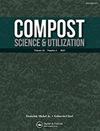不同来源堆肥茶细菌群落的遗传分析及体外酶法测定
IF 0.9
4区 农林科学
Q3 ECOLOGY
引用次数: 6
摘要
摘要堆肥茶已在世界各地被用于控制疾病和促进植物生长。微生物群落是参与对抗相关植物病原体和刺激植物生长的主要因素。本研究的目的是确定四种堆肥中存在的细菌多样性,以及堆肥茶对作物产生积极影响的一些机制。从四种不同的堆肥中获得了充气(ACT)和非充气(NCT)堆肥茶:废蘑菇基质堆肥(SMC)、葡萄渣堆肥(GMC)、温室园艺作物残留物堆肥(CRC)和蚯蚓堆肥(CRV)。获得了每种堆肥茶的基于16S rDNA的DGGE图谱,并分析了它们各自的细菌群落。在获得的100个克隆中,选择了那些典型的在所有图谱中占优势的克隆。总共对20个不同的克隆进行了测序。结果表明,大多数堆肥茶的细菌群落具有较高的丰富度、多样性和均匀度,属于拟杆菌门和变形菌门的物种相对丰富。从所有堆肥中获得的NCTs,特别是CRC和CRV,显示出高水平的铁载体产生,而来自GMC的茶显示出高且一致的纤维素酶活性。所有堆肥中的ACTs,特别是SMC,都具有较高的蛋白酶活性。本文章由计算机程序翻译,如有差异,请以英文原文为准。
Genetic Analysis and In Vitro Enzymatic Determination of Bacterial Community in Compost Teas from Different Sources
Abstract Compost tea has been used throughout the world to control diseases and promote the growth of plants. The microbial community is the main factor involved both in the antagonistic effect against relevant phytopathogens and as a stimulator of plant growth. The objective of this research is to determine the bacterial diversity present in four types of compost as well as some of the mechanisms that may be involved in the positive effects of compost tea on crops. Aerated (ACT) and non-aerated (NCT) compost teas were obtained from four different composts: spent mushroom substrate compost (SMC), grape marc compost (GMC), greenhouse horticultural crop residues compost (CRC), and vermicompost (CRV). 16S rDNA-based DGGE profiles were obtained for each compost tea and their respective bacterial communities were analyzed. Of the 100 clones obtained, those typical for being dominant for all profiles were chosen. In total, 20 different clones were sequenced. The results showed that the bacterial communities of most compost teas had high richness, diversity, and evenness values, with relative abundance of species belonging to Bacteroidetes and Proteobacteria. The NCTs obtained from all the composts, especially CRC and CRV, showed high levels of siderophore production, while teas from GMC manifested high and consistent cellulase activity. The ACTs from all the composts, especially SMC, had high protease activity.
求助全文
通过发布文献求助,成功后即可免费获取论文全文。
去求助
来源期刊

Compost Science & Utilization
农林科学-生态学
CiteScore
4.10
自引率
0.00%
发文量
0
审稿时长
>36 weeks
期刊介绍:
4 issues per year
Compost Science & Utilization is currently abstracted/indexed in: CABI Agriculture & Environment Abstracts, CSA Biotechnology and Environmental Engineering Abstracts, EBSCOhost Abstracts, Elsevier Compendex and GEOBASE Abstracts, PubMed, ProQuest Science Abstracts, and Thomson Reuters Biological Abstracts and Science Citation Index
 求助内容:
求助内容: 应助结果提醒方式:
应助结果提醒方式:


